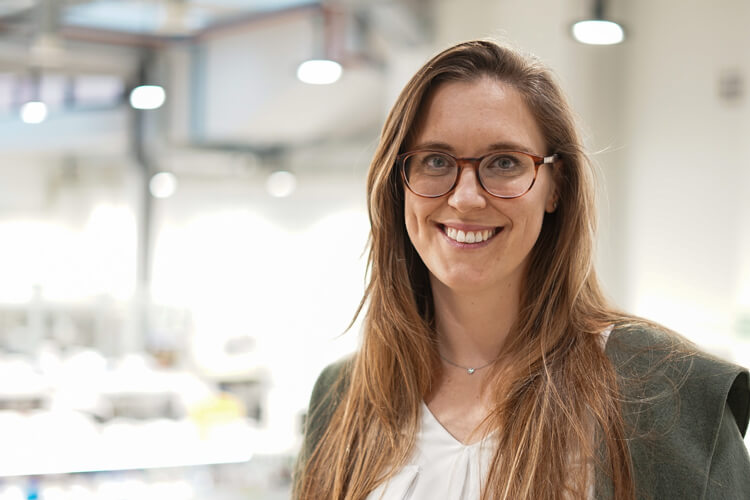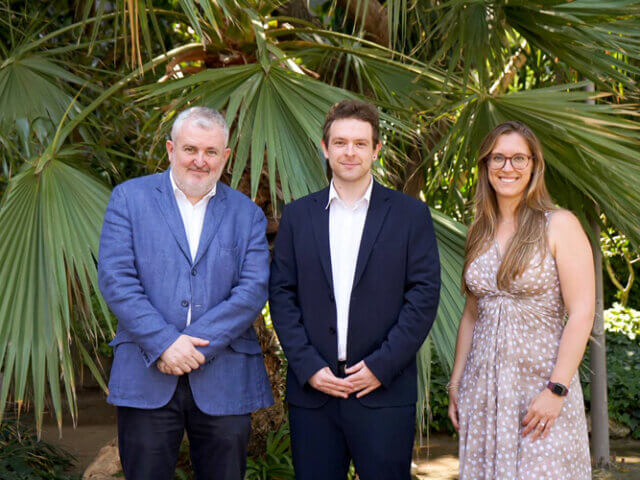Interview with Dr. Núria Oliva

Dr Núria Oliva, a researcher with the Materials Engineering Group (GEMAT), is leading the Hydrolage project at IQS. The main objective of this project is to seek a treatment for osteoarthritis by combining a biomaterial that mimics cartilage tissue (which progressively disappears as a result of the disease) with a gene therapy enabled by RNA nanoparticles, simultaneously supporting the treatment of inflammation produced by osteoarthritis and generating new cartilage. To carry out this project, Dr Oliva has obtained one of the prestigious Junior Leader Retaining fellowships awarded by the La Caixa Foundation.
We recently spoke with Dr Núria Oliva about her research career and her return to IQS.
Núria, you went to MIT to do your doctoral thesis and now you’re back at IQS 13 years later as a professor and researcher. What has your career path been like over this time?
When I finished my studies in Organic Chemistry at IQS, I went to the Massachusetts Institute of Technology (MIT) for a one-year research stay with Dr Elazer Edelman and Dr Natalie Artzi. I discovered that I really liked research, so I started a doctoral program in 2011 taught between Harvard University (where you initially work in medicine) and MIT (where you attend engineering classes). The doctorate is a bridge between both disciplines, with a vision of engineering as a solution to medical problems. I took classes in biomaterials and different areas of medicine, starting my initial research in the development of bioadhesives to seal wounds in the gastrointestinal tract. A high percentage of gastrointestinal surgeries have wound oozing problems around the sutures, leading to inflammation and infections of the peritoneal area. The use of injectable adhesives is ideal for sealing these wounds and preventing oozing after surgeries. This line of research is currently in preclinical trials at a startup in the United States.
That said, I had always wanted to do research on cancer too. So in the second part of the PhD, and with the same biomaterials, I started to develop nanoparticles to release drugs locally within the tumour in cases of breast cancer, aiming to avoid the side effects of systemic chemotherapy.
After finishing my PhD, I did a one-year postdoctoral fellowship at Harvard. We started doing preclinical trials of this nanotechnology in mice and we saw that, in addition to reducing the size of tumours, these treatments showed no side effects. It was very promising.
In 2018, I earned a TECNIOspring Plus (MSCA) grant from ACCIÓ for a collaborative technology transfer project between IQS (GEMAT group, Dr Salvador Borrós) and Imperial College London (Dr Ben Almquist’s group), the HydromiRNA project. In this case, we developed a biomaterial, also injectable, that released RNA nanoparticles to treat and heal diabetic foot ulcers. It’s a really interesting line of research because people with these issues have a very poor quality of life, are always in pain, and have restricted mobility, and it is the main cause of non-traumatic amputations. We observed that the nanoparticles that release this therapeutic RNA help cells to grow and regenerate tissue. Since the dressing is injectable and adapts to the wound, there is a lot of contact and you can release this treatment inside the ulcer. So we’re making great progress!
At the same time, I decided to sign up for the IC Medtech superconnector incubator programme, which helps researchers with promising medical technologies to contact doctors and patients, thereby being connected with the possible market where they can take their technologies. And in September 2020, in the midst of the pandemic, I earned one of the prestigious Imperial College Research Fellowships to start my own independent research group.
In addition to continuing research into diabetic foot ulcer dressings, I began other lines of research that I have now brought with me to IQS, including nanotechnologies to selectively deliver chemotherapy into cancer cells, bioadhesives to minimize scarring, and injectable biomaterials for regenerating tissue such as cartilage.
“I spent 13 years away, but I’ve always maintained my connections with IQS and the GEMAT group”
During all this time you continued collaborating with IQS and the GEMAT group. What made you return to IQS now to continue developing your research and academic career?
The collaboration has been ongoing: when I was at MIT in the United States, helping students who came from IQS to study abroad, then at Imperial College London as well when I jointly supervised master’s and doctoral students with Dr Salvador Borrós.
I spent five years in the UK, but I never left IQS and my research has always been connected to the school, especially the GEMAT group. Now, I’m coming “home” with this fellowship from La Caixa Foundation. It’s a homecoming that has involved a lot of hard work and a great deal of preparation. We took advantage of the Junior Leader fellowships call from La Caixa to apply for one and bring me back to IQS as an associate professor within the GEMAT group. That said, I have not had to set aside my research in London, which will continue with an Engineering Physical Science Research Council (EPSRC) New Investigator Award for two more years.
“I returned to IQS because the school’s values are greatly in line with my own. It’s an incredibly favourable environment for researchers”
Now I officially form part of the research group and I’m a professor at IQS. And I’ve come back because IQS’s values today are in line with what I am seeking. They fit really well with what I’ve always been looking for. The academic world is very competitive and sometimes terribly hard. It’s essential for an institution to care about its researchers and about the research lines of the future – and you can really feel that here today.
I’ve always had a lot of support and great harmony with Dr Salvador Borrós, coordinator of the GEMAT group and the current Director of IQS. That’s why I came back, because I know I’ll be working a place with immense professional quality where I’ll feel supported in a very favourable environment for researchers.
What does it mean to you to have earned this prestigious Junior Leader Retaining fellowship?
They are very competitive fellowships, definitely. There were more than 300 applications, out of which they held 30 interviews and awarded 15 fellowships. I earned first place in the ranking, with a great score. I’m really happy and satisfied about it!
This is my second fellowship from La Caixa. With the first one I was able to go to the United States. Now it’s coming back full circle: La Caixa helped me go abroad and now La Caixa is bringing me home.
At the same time, I also earned a Ramón y Cajal grant, which I had to turn down due to the incompatibility of the aid awarded.
With this fellowship you’re returning to IQS to carry out the Hydrolage project. Can you tell us a little bit about some of the goals you are pursuing?
I started this project at Imperial College London. We saw that there was a problem with osteoarthritis, a degenerative disease that affects one in three people over the age of 45, is incredibly painful, and ends up with the disappearance of the cartilage in the joints and bone rubbing against bone. It is currently treated with just anti-inflammatories, and this treatment is ineffective considering the absence of blood vessels in the cartilage. The alternative to this treatment, hyaluronic acid injections, is not the solution either as they are ineffective in joints such as the knee (which must bear a lot of weight) due to the gelatinous consistency of the acid itself.
In the Hydrolage project we are seeking an injectable biomaterial with mechanical properties similar to the cartilage itself, such as greater hardness (to be able to support the body’s weight), and that also gives the appropriate signals to make the cartilage cells “feel” a natural environment (through chemical, mechanical, and biological forces), thus avoiding unwanted processes such as the transformation of cartilage cells into bone cells or the activation of inflammatory processes that degrade the cartilage.
Putting all this into one material is highly complicated, and even more so if we are seeking a minimally invasive route of administration such as injectable or laparoscopic surgery. However, the translational part will later present a simpler and cheaper solution, avoiding traditional open surgeries and decreasing hospitalization and recovery times after surgery. We already have a prototype that we want to develop within this project based on chondroitin, the main component of cartilage tissue, but which is very soft. We have chemically hardened it, but at the same time it can be injected and can, first of all, replace the cartilage deteriorated by osteoarthritis. In the second phase, we will study how to regenerate cartilage from the action of this biomaterial on the chondrocytes themselves (responsible for altering the immune response of the system and increasing the deterioration of cartilage tissue). And in the final phase, we’ll combine these injectable biomaterials with RNA therapies to treat inflammation.
It’s a really “cool” project that can greatly improve the quality of life for the elderly and also produce excellent outcomes in sports medicine.
The Hydrolage project is funded by the “la Caixa” Foundation’s Junior Leader Postdoctoral Fellowships 2022 call for proposals.
RELATED PEOPLE:
RESEARCH GROUP
Materials Engineering
Chemical & Synthetic Biology for Biotherapies
RELATED PROJECTS
Biomaterials Osteoarthritis (Combination of tough biomaterials and nanotechnology-enabled gene therapy to regenerate cartilage)





